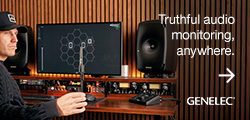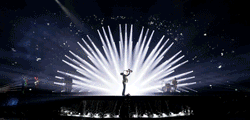![]() Assuming the Netherlands throne on the abdication of Queen Beatrix, the coronation of Willem-Alexander centred on a grand ceremony that was broadcast live by Dutch national broadcaster, NOS, as well as being relayed to other countries’ broadcasters.
Assuming the Netherlands throne on the abdication of Queen Beatrix, the coronation of Willem-Alexander centred on a grand ceremony that was broadcast live by Dutch national broadcaster, NOS, as well as being relayed to other countries’ broadcasters.
The event was also marked by concerts from Dutch violin superstar, Andre Rieu and the Royal Concertgebouw Orchestra.
Handled by Dutch full service specialist United, the broadcast of the day’s events required a total of 160 cameras, with Jeroen ‘Huub’ Lelieveld serving as sound supervisor for the official ceremonies at the royal palace in Dam Square and the Nieuwe Kerk.
The coronation on air…
Central to the audio operation was United’s OB14, one of four Lawo mc266 vehicles operated by the company. With 12 layers of 56 faders on the console and comprehensive audio control from its MkII Router, the truck is regularly used for 192-channel multitrack recording.
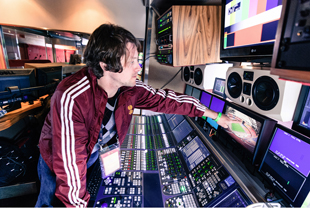 ‘Our Lawos are used for every kind of job you can imagine,’ Lelieveld says. ‘They are our central audio routers, controlled by VSM software, and we use them on complicated sports events, big live events, shows and music.’
‘Our Lawos are used for every kind of job you can imagine,’ Lelieveld says. ‘They are our central audio routers, controlled by VSM software, and we use them on complicated sports events, big live events, shows and music.’
To date, this includes major football events, multitrack recordings of major music concerts (Andre Rieu at the Vrijthof, Coldplay at the Paris Stade de France and Toto in Italy among them) and a Red Hot Chili Peppers album launch, which was broadcast live to cinemas worldwide using the mc266’s Ambit upmixing module to deliver stereo segments in 5.1 surround.
‘I heard the mix in a cinema and was very impressed by the sound of the Ambit algorithm on cinema speakers,’ Lelieveld says.
The scale of the ceremony necessitated redundancy at every point: ‘For both NOS and us, the most important thing was the quality of the broadcast,’ Lelieveld says. ‘So I was able to prepare thoroughly, with several site visits beforehand, when I tested out different microphones and microphone set-ups. We had double mics for all of the important sources – for the Queen and new King in both the abdication and coronation ceremonies, and for the speech that was made from the Nieuwe Kerk balcony in Dam Square.
‘We started setting up five days before the event, and we had one big rehearsal with Willem-Alexander and his wife Maxima the day before the big event,’ he adds. ‘During the rehearsals, Willem-Alexander was nice enough to spontaneously give me a soundcheck from the throne – both sitting down and standing up.’
The duplicate mics were supported by redundant audio connections, with all signals patched into a Lawo Dallis stagebox and into copper multicore cables fed to the local I/O of the mc266 console in the OB14 truck. The signals on copper cable were also patched into a United second truck handling the national programme, which would also be ready take over in case of a failure in the main truck. ‘I used about 160 input channels on the mc266, as well all (15) copper 12-pairs and 56 channels of the stagebox on fibre,’ says Lelieveld.
‘The PA company in the church also took an analogue split from the microphones, so you can imagine that with so much copper and three parties connected to these microphones, it was quite a challenge to keep the signals hum- and buzz-free without compromising the safety of the broadcast.
‘In the end, we had to use an active splitter in the church – which is, of course, a single point of possible failure, but a king's speech with a bit of buzz is no option really…’
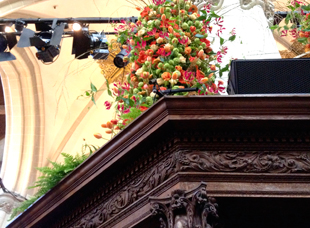 On the day, however, none of the backup provisions were needed.
On the day, however, none of the backup provisions were needed.
‘A challenging part of the abdication/coronation ceremony was the oath of the members of parliament,’ Lelieveld says. ‘A total of 250 members of parliament took their oath during the coronation ceremony in the Nieuwe Kerk. All 250 people had to be heard on the television broadcast but no microphones were permitted to be visible. This was an interesting challenge, obviously.’
A pair of Neumann KM150 supercardioids were placed in front of the throne – two mainly for redundancy, but aimed slightly differently as the new king’s speech was given sitting down while his oath was given standing up. Then there were all those Members of Parliament…
The Members of Parliament were seated over a fairly large area and the church is very high, so it was impossible to hang mics,’ Lelieveld explains. ‘Also, a technocrane camera and a railcam, which was rigged in the ceiling of the church, moved over the same area, so any hung microphones would have been visible, which was unwanted by director Jan de Roode of the NOS.
‘I had to wait until the evening before the event to finally hear if my original plan – about 28 Sennheiser 416 shotguns hidden in the flower decorations and four PCCs on the floor in front of the first row – would work. I rehearsed the oath by having the guys in my sound team standing up and talking from each of the 250 chairs, writing down which shotgun or hidden omni for each chair sounded best.
During this rehearsal we discovered some dead spots. I had brought an eight-channel Wisycom radio receiver for this purpose, and we were able to cover the dead spots with Sennheiser MKE 2 lavalier mics on Wisycom beltpacks, which we gaffer taped to the back of some chairs.
‘Of course, some mics were fairly distant and raising their fader also brought up some background noise. To reduce background noise I had two Cedar DNS 1500 dialogue noise supressors, one for general dialogue – used carefully – and one for the oath, with a more extreme settings.
Later that day, a Royal Ball was held in Amsterdam’s Museum Square, where Andre Rieu performed along with guest artists. Again the Lawo mc266 (with additional hardware from ABS) was used to mix and record about 200 channels of audio.
Costing €12m, the royal succession ceremonies drew royalty from around the world, as well as attracting thousands of spectators to Dam Square. Prince Charles and Camilla came in from the UK, along with royalty from Denmark, Thailand, Qatar and Japan.
Concert time
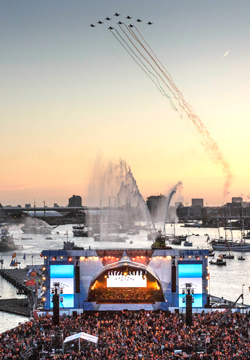 After the festivities, the Royal Family took to the River IJ for a Royal Boat Parade. Passing islands around Amsterdam, they were treated to snatches of entertainment from sport to dance and opera. Reaching Java Eiland, the procession joined a crowd of 20,000 for a regal, yet contemporary concert by the Royal Concertgebouw Orchestra, with Dutch DJ Armin van Buuren.
After the festivities, the Royal Family took to the River IJ for a Royal Boat Parade. Passing islands around Amsterdam, they were treated to snatches of entertainment from sport to dance and opera. Reaching Java Eiland, the procession joined a crowd of 20,000 for a regal, yet contemporary concert by the Royal Concertgebouw Orchestra, with Dutch DJ Armin van Buuren.
Peak Audio and d&b audiotechnik, provided the sound system for the event but due to the large crowd and the outdoor venue, they were allowed only one day for load-in, soundcheck and rehearsal.
They chose a d&b J-Series was for the main array and subwoofers, with V-Series components for out fill and monitors. ‘It was a tricky venue, because the island is just an open space,’ says Peak Audio’s Will-Jan Pielage. ‘We had to be very intentional with directing the sound and setting up delays, so that no matter where people were standing they would be able to enjoy the show. With very little time at the actual venue, we used ArrayCalc to map out our strategy long before arriving on the island. For something as big as this, we wanted to be ready for anything.’
The 35-minute concert was also televised throughout the Netherlands.
‘This is a project I’m particularly proud of,’ Pielage adds. ‘It is not every day we get to work on a show for a king. ‘As a Dutch person, this was a very important event, and it went off without any problems.’








